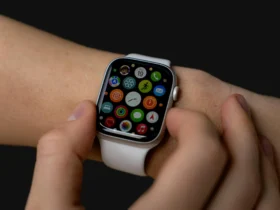Last Updated on February 17, 2025 by Daniele Lima
How wearable technologies are transforming our routine
In recent years, wearable technology has become one of the most significant advancements in the way we interact with the world around us. Devices like smart watches, smart headphones, and augmented reality glasses have transformed our routines, making connectivity more accessible and personalized.
The concept of “One Touch Technology” encapsulates this wearable device revolution, where the perfect integration between the digital and the physical redefines daily habits, health, productivity, and even the way we communicate. This article explores how these wearables are shaping the future, offering practical, smart solutions to everyday problems while creating new opportunities for well-being and entertainment.
In addition to facilitating access has information and improving quality of life, wearable technology expands its capabilities through a collection of data and real-time analysis. Sensors incorporated on devices like tracks of fitness and smart clothing monitor vital signs, sleep patterns, and even the same stress levels, allowing for unprecedented personalization of the care of health. Combined with the Technology One Touch, these devices allow to users make instant and informed decisions, promoting a more balanced and connected lifestyle. Thus, the future promises not only comfort but also a significant increase do well-being and and quality of life.
Table of Contents
What is Wearable Technology: A Beginner’s Guide
Wearables or wearables are electronic devices that can be worn on the body, either as fashion accessories, as part of clothing, or integrated into the objects we use on a daily basis. The most popular include smart watches, fitness bands, augmented reality (AR) glasses, and smart headphones. They collect real-time data, monitor activities, and provide immediate feedback to users, whether through visual alerts, sound, or vibrations.
The ability to connect these devices to smartphones or wireless networks is what makes the experience truly innovative. With a tap or voice command, the user can access information, monitor health metrics and even control other connected devices.
Smart Health Monitoring: Wearable Devices in Healthcare
The Role of Wearable Technology in Health
Wearable health devices are revolutionizing personal healthcare by providing real-time insights into vital signs, activity levels, and overall wellness. These smart gadgets empower users to take control of their health while enabling doctors to monitor patients remotely.
Key Benefits of Wearable Health Devices
- Heart Rate & Oxygen Monitoring: Devices like the Apple Watch and Fitbit track heart rate, blood oxygen levels, and detect irregular heart rhythms.
- Sleep Tracking & Recovery Insights: Smartwatches analyze sleep patterns, helping users optimize rest and improve overall well-being.
- Fitness & Activity Tracking: Step counting, calorie burning, and exercise reminders encourage users to maintain a healthier lifestyle.
- Stress & Meditation Guidance: Many wearables offer guided breathing exercises and stress management tools to promote relaxation.
- Remote Health Monitoring: Users can share data with doctors for early diagnosis and chronic disease management.
The Future of Wearable Healthcare
As technology advances, wearable devices will integrate with AI-driven health platforms, providing even deeper insights into disease prevention, mental health tracking, and overall wellness optimization.
Learn More About Wearable Health Tech
AI and Machine Learning in Wearable Technology

The evolution of wearables would not be possible without parallel advances in artificial intelligence (AI) and big data. With greater data processing capacity, these devices are capable of analyzing information quickly and efficiently. The use of AI allows these devices to personalize health recommendations based on the user’s behavior, creating exercise programs tailored to their needs and suggesting changes to daily habits to improve well-being.
This use of large-scale data has important implications for public health. By analyzing anonymous data from millions of users, technology companies can identify patterns that help predict epidemics or emerging health trends.
Smart Wearables in the Workplace: Productivity Benefits
Wearable technology isn’t just for health, it’s also transforming the way we work. Smart headphones, like AirPods from Apple or Amazon’s Echo Buds, are a good example of how portable devices change work routines. With them, you can make calls, listen to music, participate in video conferences, and even control smart home devices with simple voice commands.
Another innovation in the area of productivity is the use of augmented reality glasses. Companies like Microsoft, with HoloLens, are exploring how AR can optimize work processes, especially in areas such as engineering, design, and education. These glasses allow you to overlay digital information directly on the user’s field of vision, making it easier to view 3D projects, carry out inspections, or train without the need to be physically present.
For those who work remotely, devices such as smartwatches also offer convenience, allowing users to receive important notifications, respond to messages, or even make payments without having to use their smartphone. Seamless connectivity makes everyday life more agile, without the need to interrupt the workflow for small tasks.
Wearable Tech Entertainment: VR and AR Innovations
Wearables are also changing entertainment and lifestyle. The smart headphones, as previously announced, not only offer superior sound quality but also allow integration with virtual assistants like Siri, Google Assistant, and Alexa. This means that in addition to listening to music, the user can search for information, control household appliances, and perform various tasks without having to look at the cell phone screen.
Virtual and augmented reality glasses are also gaining importance in the entertainment field. With them, you can watch immersive movies, play video games in 3D environments, and even discover new forms of social interaction in the virtual world. These devices push the limits of what we consider possible in entertainment, offering increasingly immersive and interactive experiences.
Smart Fashion: The Future of Wearable Devices
Another interesting aspect of wearables is how they are integrated into fashion. Big brands collaborate with technology companies to create devices that are not only functional but also stylish. One example is the collaboration between TAG Heuer and Google, which resulted in luxury smartwatches that combine cutting-edge technology and refined design.
Smart clothes have also been gaining ground in the market, with fabrics capable of monitoring the user’s vital signs or adapting to weather conditions. These pieces combine style and functionality, offering comfort and practicality without compromising aesthetics.
⏳ Smart Device Battery & ROI Calculator
Optimize battery performance and calculate business ROI for wearable tech investments.
🔋 Battery Life Estimator
Estimate how long your device battery will last based on usage patterns:
Heart Rate Monitoring Notifications
💰 Business Wearable ROI Calculator
Determine the financial benefits of investing in smart wearables:
Explore more about latest wearable trends.
Read about top smartwatches of 2025.
Wearable Technology Trends 2025: Challenges and Solutions
Despite many advances, wearables still face challenges such as data privacy and security issues. The volume of sensitive information collected by these devices raises concerns about who has access to this data and how it is used. However, as technology advances, more robust security solutions must be implemented to guarantee user privacy.
In the future, we can expect even deeper integration between wearables and other aspects of our lives. With the advent of 5G and advances in the Internet of Things (IoT), these devices will have even faster and more efficient connections, enabling new applications that today seem remote.
Conclusion: A Touch That’s Here to Stay
The clothing revolution has just begun. They are no longer just accessories, but powerful tools that transform the way we live, work and play. With constant innovation and increasing integration with other technologies, these wearables promise to redefine our future, making technology even more accessible and present in all aspects of everyday life. Whether it’s health, work or entertainment, One-Touch technology is here – and it’s here to stay.
Frequently Asked Questions About Wearable Device Revolution
What are the most popular types of wearable devices?
The most common wearable devices include smartwatches, fitness trackers, AR glasses, and smart earbuds. Popular brands like Apple Watch, Fitbit, and Google Glass lead the market in these categories.
How do wearable devices monitor health?
Wearable devices use various sensors to track vital signs like heart rate, blood oxygen levels, sleep patterns, and physical activity. They can also detect irregular heart rhythms and share this data with healthcare providers.
Are wearable devices secure?
Modern wearable devices implement strong encryption and security measures to protect user data. However, it’s important to buy from reputable manufacturers and regularly update your device’s software.
How much do quality wearable devices cost?
Prices vary widely, from $50 for basic fitness trackers to $500+ for premium smartwatches. AR glasses and specialized medical wearables may cost more.
Can wearable devices replace smartphones?
While wearables offer many smartphone features, they’re designed to complement rather than replace smartphones. They excel at quick interactions and specific tasks like health monitoring and notifications.









Leave a Reply